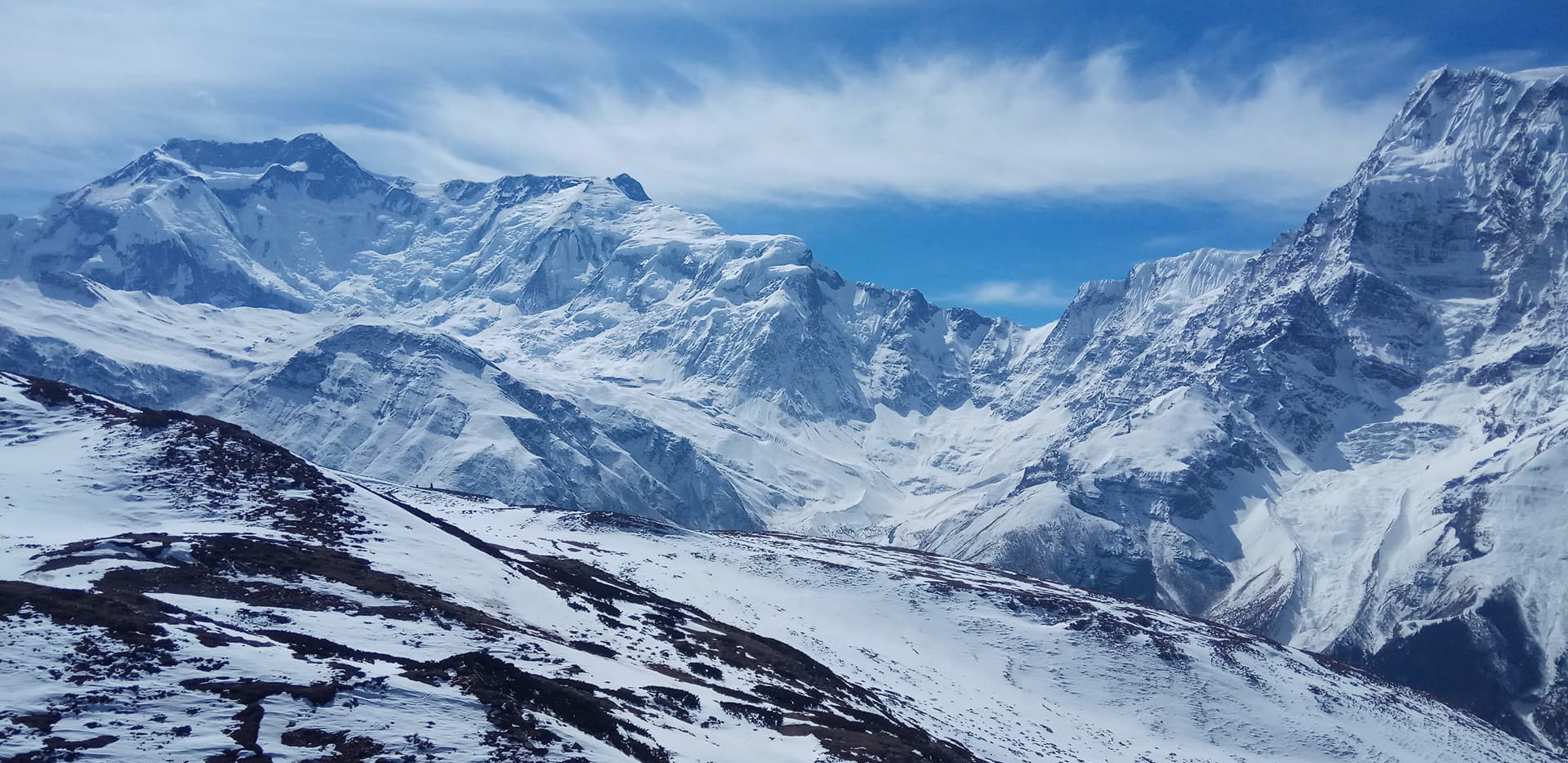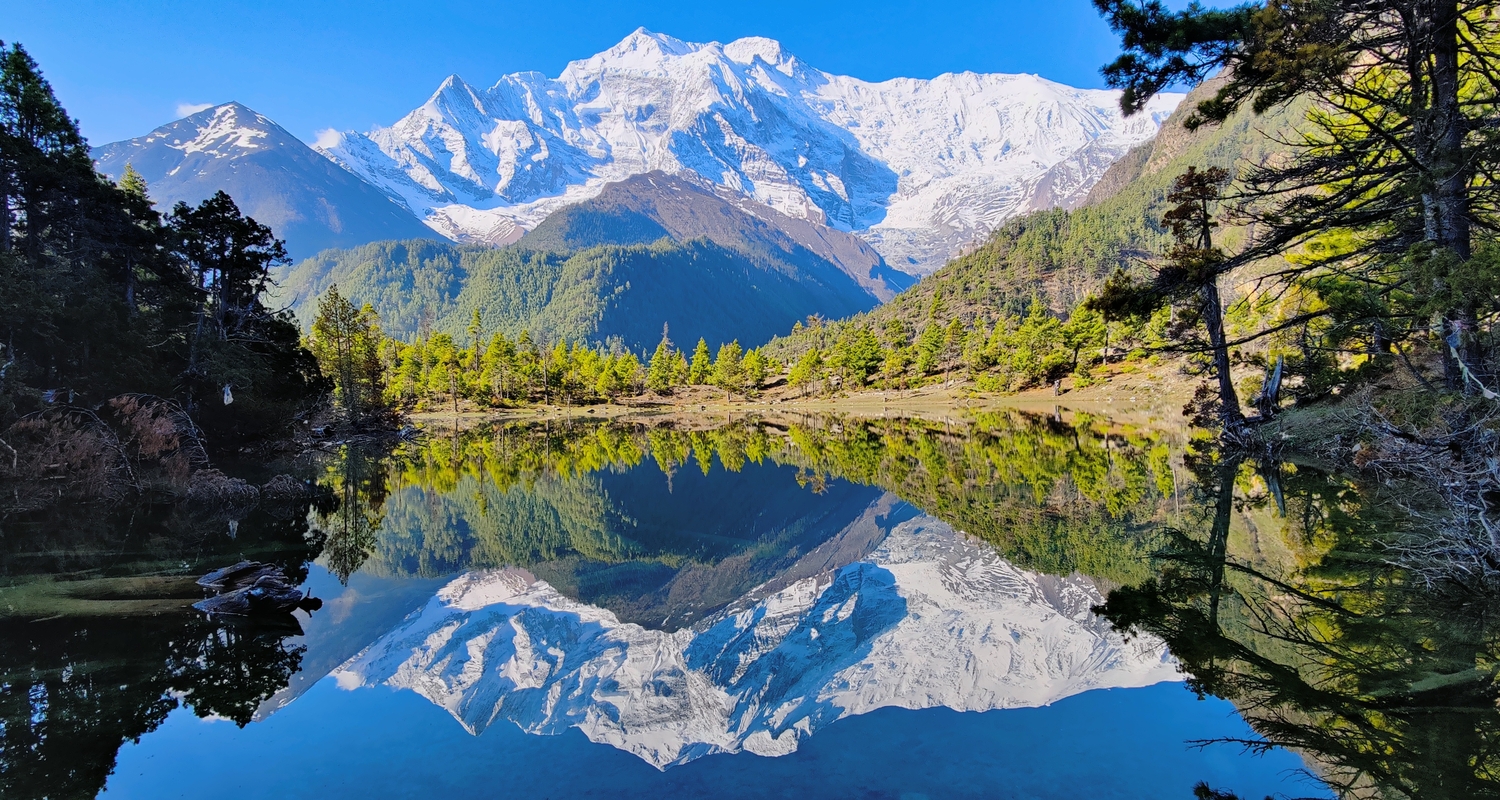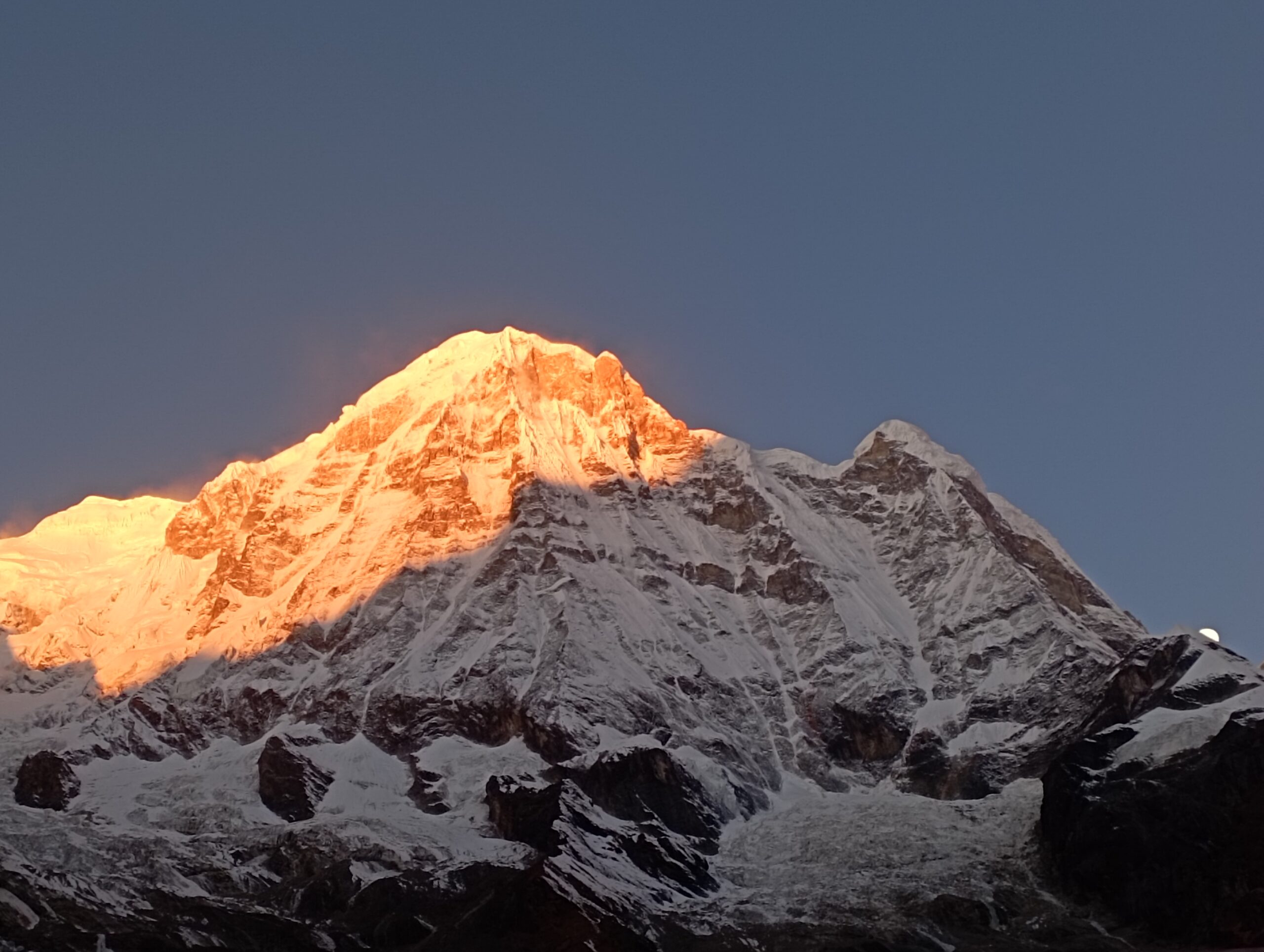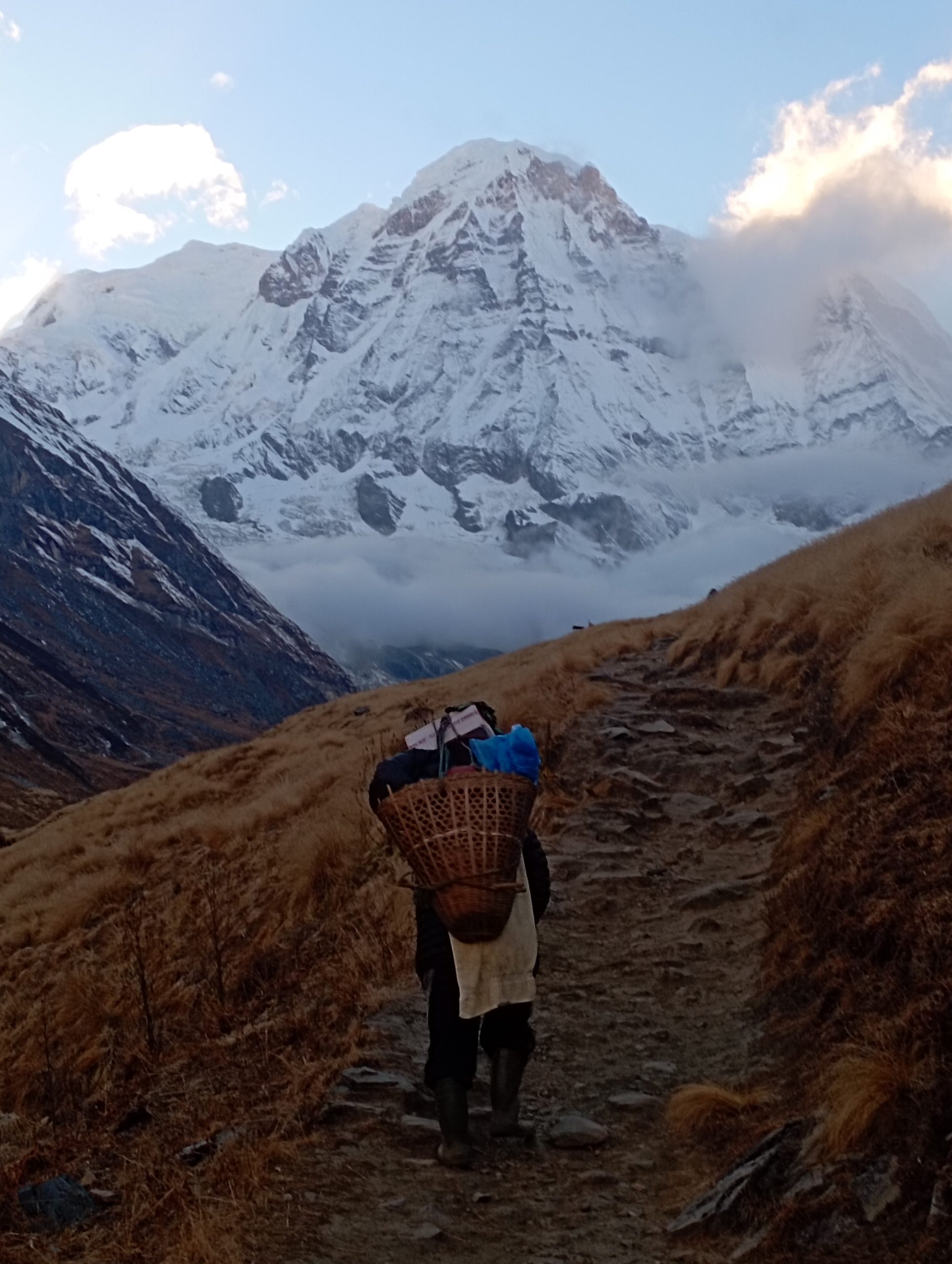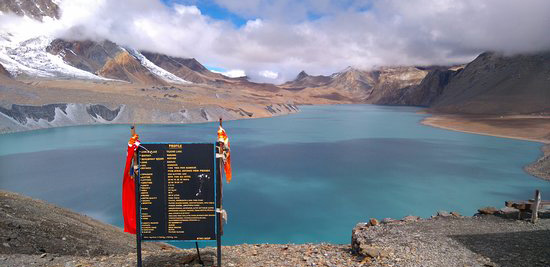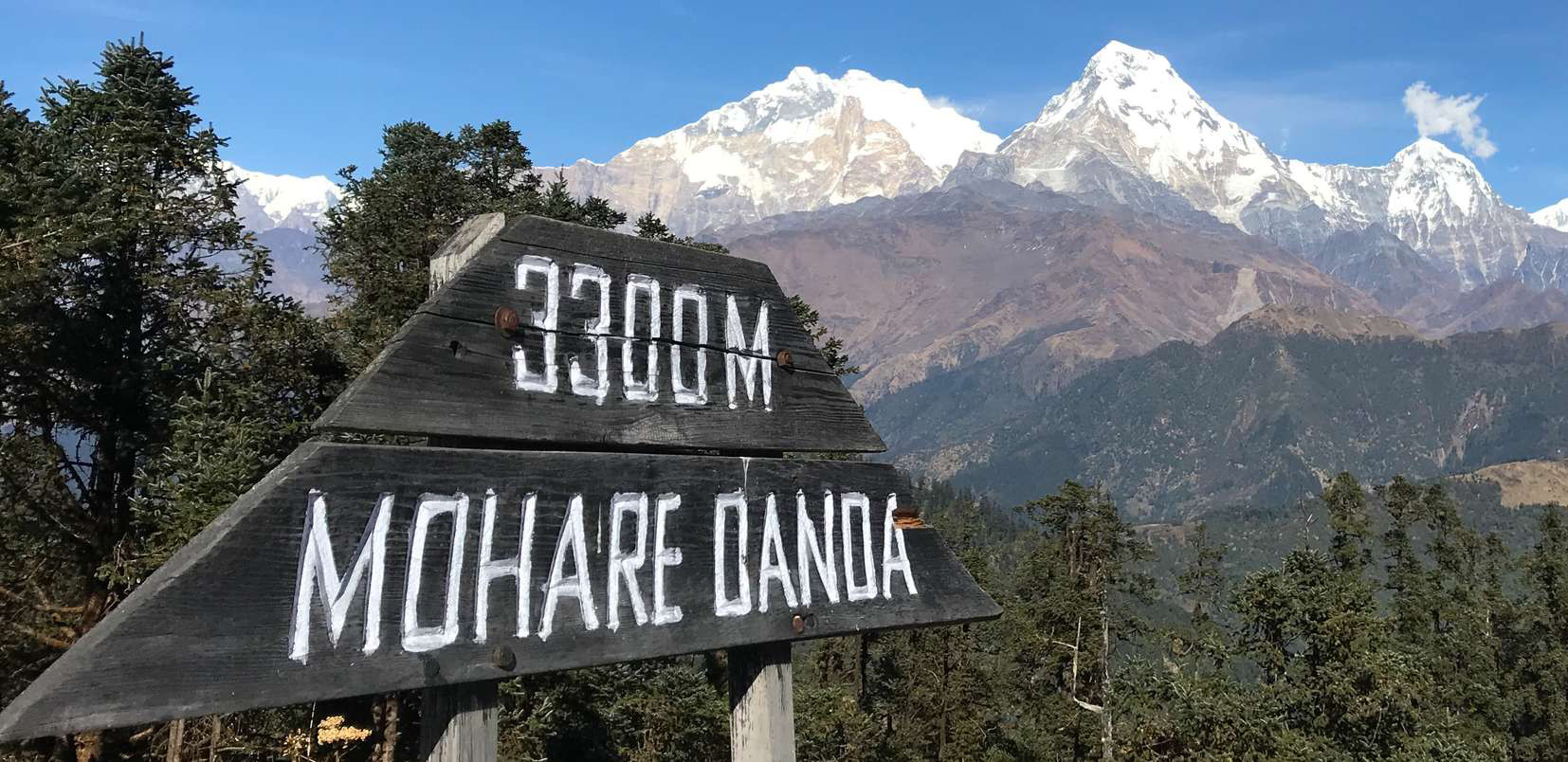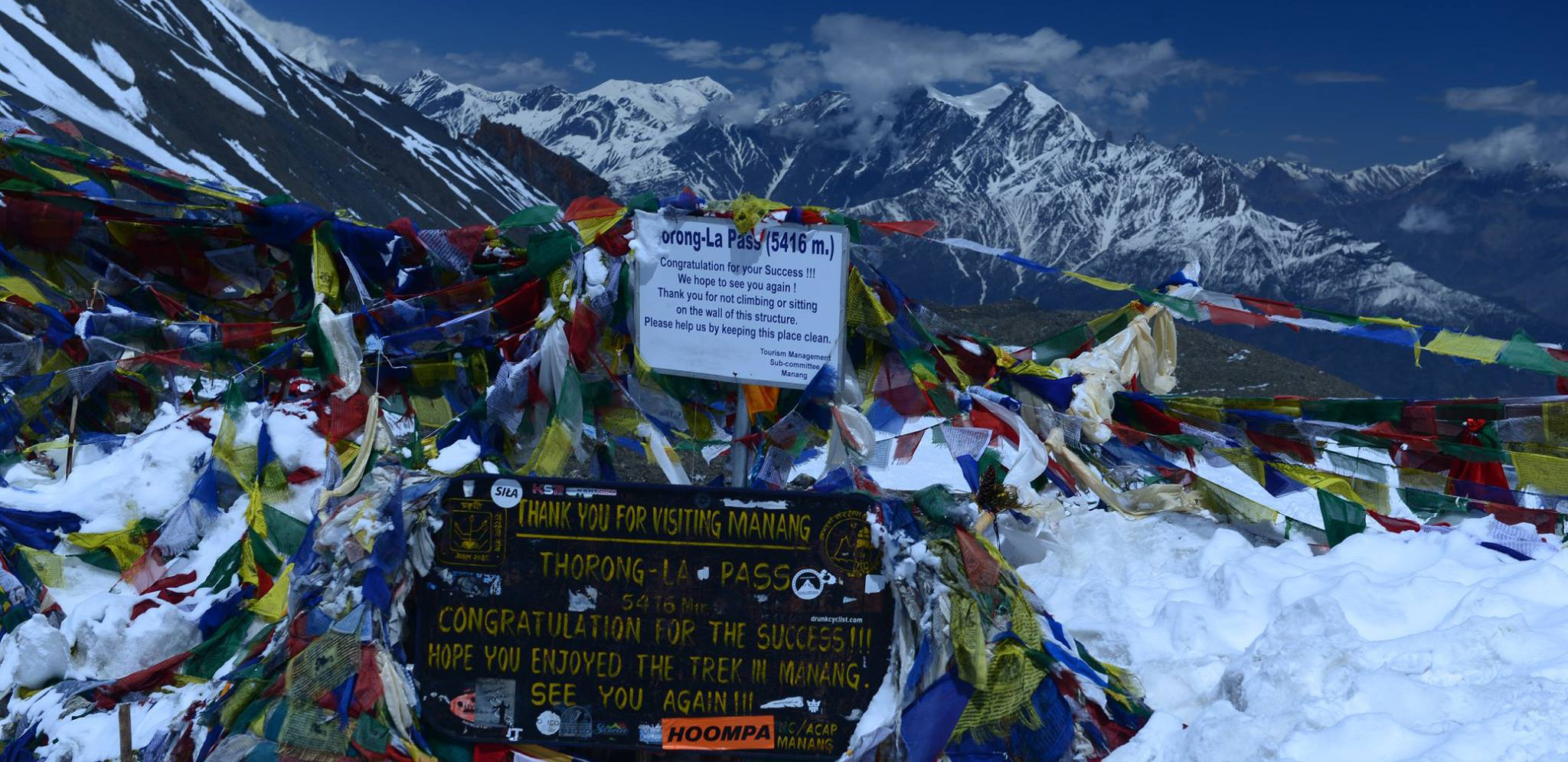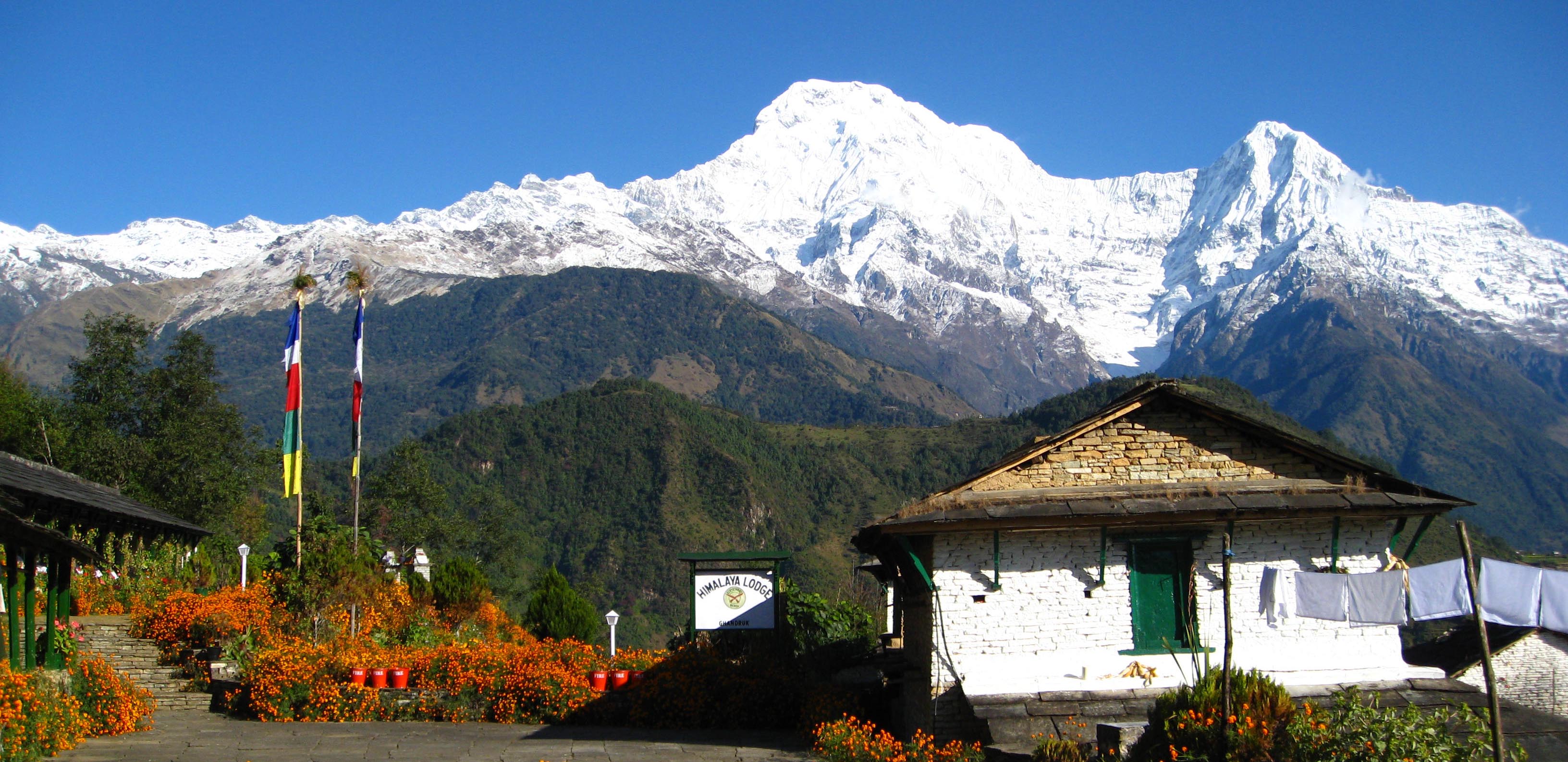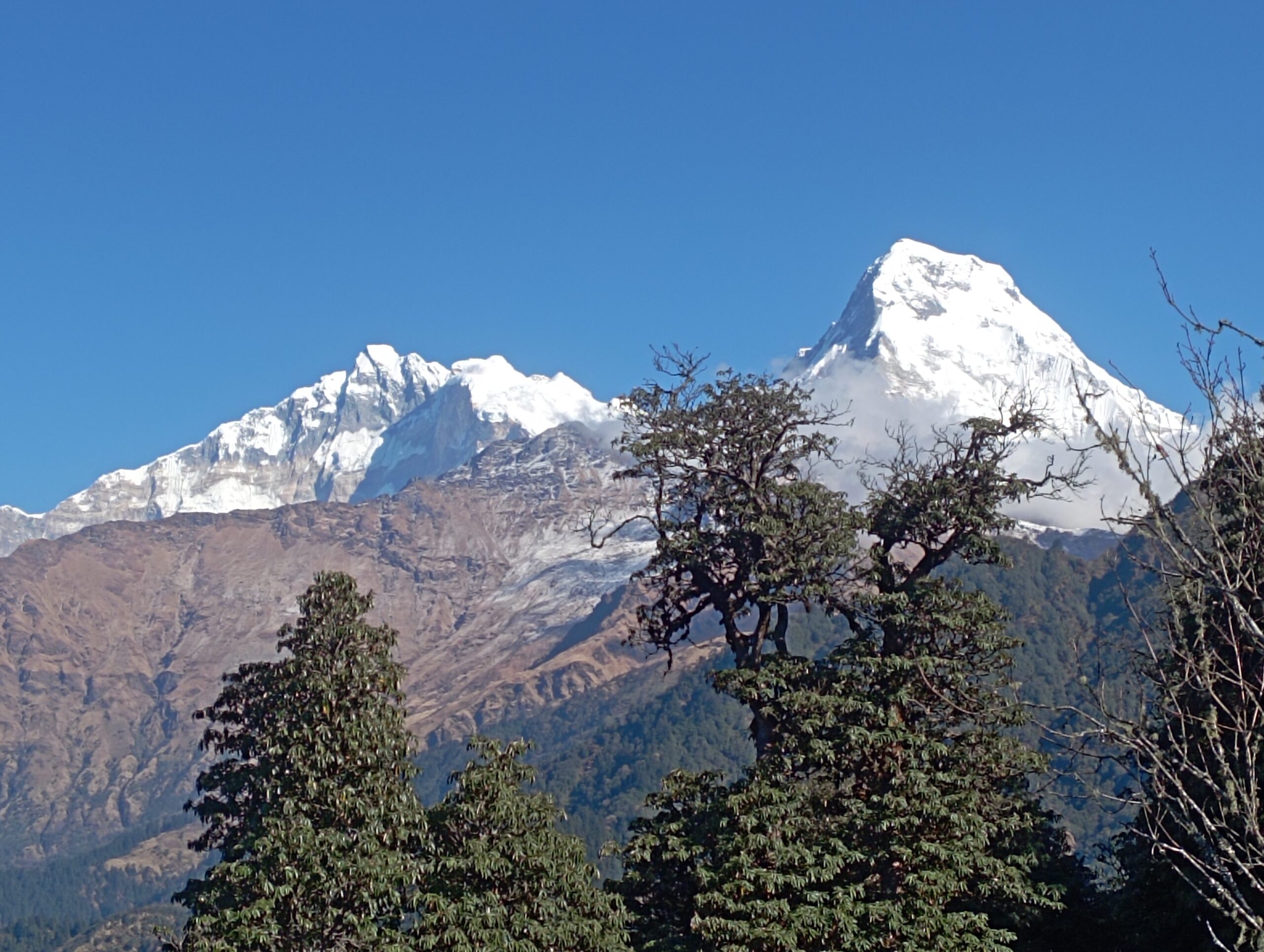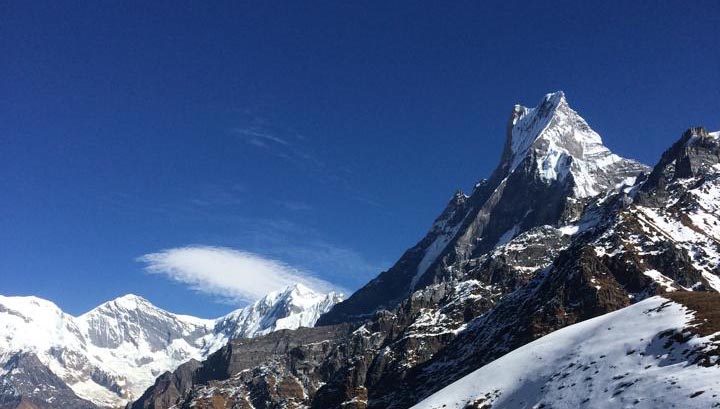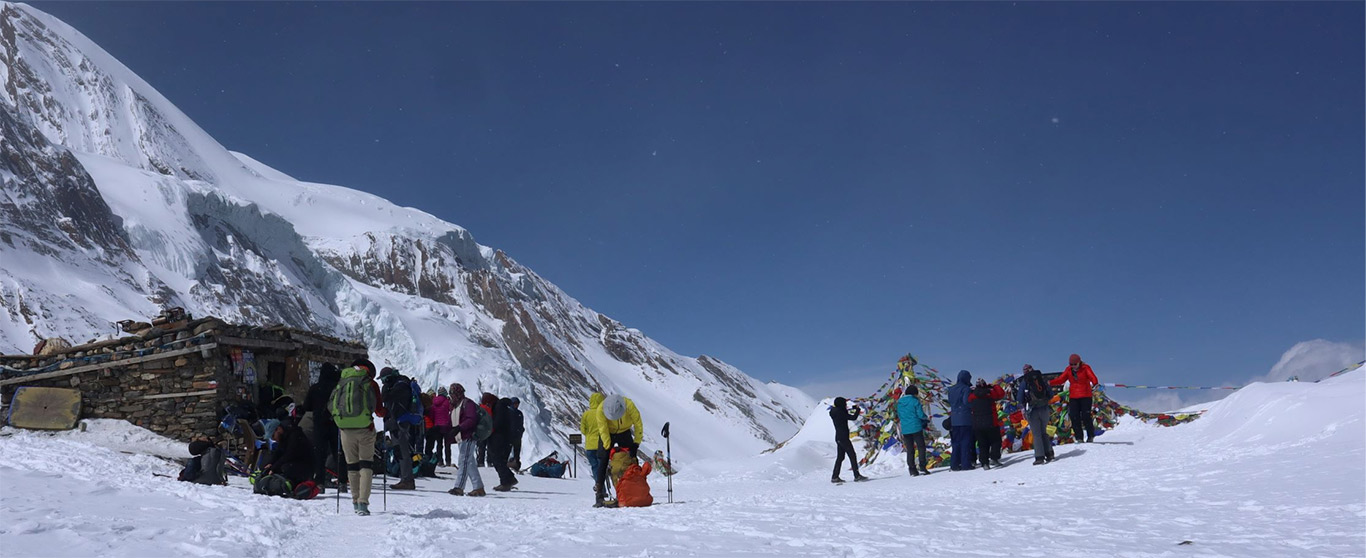Annapurna Circuit with Base Camp Trek
The massif Annapurna Mountains cover the Annapurna Region in the Northwest part of Nepal. Annapurna Circuit with Base Camp Trek provides an opportunity to explore cultural varieties, mesmerizing landscapes, high snow mountains, and different flora and fauna. Starting from Greenery hilly region our trail passes through different rivers, streams, waterfalls, fertile agricultural land, different indigenous community, and massif forest. It also offers the natural music of different chirping birds and colorful dancing butterflies on the way. The trail of Annapurna Circuit Trekking slowly and gradually leads you up to the smiling high silver mountains to the world’s biggest pass, Thorong La (5416 m) to the desert and bare hills of Mustang, where you get an impression as you are in Tibet.
Annapurna Circuit Trek is one of the most popular and classic treks in the world. This trek is not only famous throughout Nepal, but it is one of the top trekking trails in the world. There was a time when there were no roads and a minimum amount of tea houses to stay but nowadays the roads are up to Manang Village. Before starting of Annapurna circuit trek, we need to drive to Beshisahar from Kathmandu. After spending a night in Beshisahar the next morning we start a complete trek towards Thorong-La Pass via Manang and other villages. The roads are along the trail but recently TAAN and the government made optional routes to avoid the roads but still, you can hear the vehicle beeping around.
Day 01: Arrival in Kathmandu.(1,300m/4,264ft)
Day 02: Kathmandu Sightseeing
Day 03: Drive from Kathmandu to Syange (1100m/3608 ft): 7 – 9 hours
Day 04: Trek from Syange to Dharapani (1,860m/6,430ft): 6 – 8 hours
Day 05: Dharapani to Chame (2,610m/8,891ft): 4 – 6 hours
Day 06: Chame to Pisang (3,200m/10824ft): 4 – 6 hours
Day 07: Pisang to Manang (3,540m/11,482ft): 5 – 7 hours
Day 08: Acclimatization Day
Day 09: Manang to Siri Kharka (4060m/13,320ft): 4- 5 hours
Day 10: Siri Kharka to Tilicho Base Camp (4150m/13,583ft): 5-6 hours
Day 11: Visit Tilicho Lake (4,920m/16,138 ft) then back to Siri Kharka: 5-6 hours
Day 12: Siri Kharka to Yak Kharka (4060m/13,020ft):4-5 hours
Day 13: Yak kharka to Thorang Phedi: (4525m/14501 ft): 3-4 hours
Day 14: Thorong Phedi to Thorong La pass (5416 m/17764 ft) to Muktinath (3,800/12,467ft): 5 – 7 hours
Day 15: Drive from Muktinath to Tatopani (1,200m/3937 ft): 6 – 8 hours
Day 16: Tatopani to Ghorepani (2,850m/9,350ft): 7 – 9 hours
Day 17: Hike Poon Hill ( 3200 m) and trek to Tadapani ( 2630m) in 5-7 hours
Day 18: Trek to Sinuwa (2170 m) 5 – 7 hours
Day 19: Trek to Deurali (3200 m) 6 – 7 hours
Day 20: Trek to Annapurna Base camp (4130 m) 4 – 6 hours
Day 21: Trek back to Bamboo (2310m) 5 – 7 hours
Day 22: Bamboo to Jhinu Danda (1760m/5770 ft)5 – 6 hours
Day 23: Trek to New Bridge and drive to Pokhara 5 hours
Day 24: Pokhara to Kathmandu: 6- 7 hr
Day 25: Departure Day
Day 01: Arrival in Kathmandu (1300m/4264ft)
Our representative from Himalaya Sanctuary will meet you after landing and customs clearance at the Tribhuvan International Airport (TIA) then transfer you to the hotel for overnight in Thamel, Kathmandu.
Day 02: Kathmandu Valley Sightseeing (4 -6hr)
After breakfast, you will proceed on to Boudhanath Stupa, Pashupatinath Temple, Patan Durbar Square, and Swayambhunath Stupa. Swayambhunath is a Buddhist Stupa said to be more than 2000 years old, on the brink of a hillock 77 meters above the valley floor, and offering a splendid view of Kathmandu City. Afternoon, a tour of Patan, also known as Lalitpur or the “city of beauty” is one of the oldest cities in the valley. It is a great city both for the Newari Buddhist religion and traditional arts & crafts with 136 courtyards and 55 major temples. Overnight at your hotel in Kathmandu.
Included meals: Breakfast
Day 03: Drive from Kathmandu to Syange (1100m/3608 ft.): 7 – 9 hours
We drive from Kathmandu to the village of Syange for about 8 hours. On our way, we can see many attractive villages, farms, smooth rivers, and sight of stunning mountain ranges.
Included Meals: Breakfast, Lunch, and Dinner
Day 04: Trek from Syange to Dharapani (1,860m/6,430ft): 5 – 7 hours
We start our trek after breakfast and cross a suspension bridge. After a steep ascend, we enter the Tal village. Witness several waterfalls, and traverse the trail through barley, rice, and potato fields. Reach one of the biggest villages Kodo in the Manang valley. Reach Dharapani after crossing a suspension bridge and a short climb. Stay overnight.
Included Meals: Breakfast, Lunch, and Dinner
Day 05: Dharapani to Chame (2,610m/8,891ft): 4 – 6 hours enjoy the trail traversing through the forest of pine, fir, oak, and maple trees to reach the district headquarters Chame of Manang district. Walking in the vicinity of the verdant forest with a background of incredible views of Lamjung Himal, Annapurna II, and Annapurna IV. We stop at a natural hot spring where we can rest and relax for some time.
Included Meals: Breakfast, Lunch, and Dinner
Day 06: Chame to Pisang (3,200m/10824ft): 4 – 6 hours
Walk from side to side in a steep and narrow valley and get a glimpse of Paungda Danda Rock. Also, get clear views of Annapurna 2 in the south and Pisang Peak in the northeast from there. Slowly descend to enter the Pisang and spend a night there.
Included Meals: Breakfast, Lunch, and Dinner
Day 07: Pisang to Manang (3,540m/11,482ft): 5 – 7 hours
Walk on the upper trail through the Upper Pisang to witness the superb views of the north face of Annapurna II, III, IV, Gangapurna, Tilicho, and Pisang Peak. Feel the cold weather and cold wind blowing as we ascend higher. Pass through the Tibetan village and visit the largest Braga Monastery in the region. Explore the Buddhist culture and walk a bit further to reach Manang. Stay overnight.
Included Meals: Breakfast, Lunch, and Dinner
Day 08: Manang Acclimatization day
Acclimatization day is necessary for our body to adapt to the environment in higher altitudes. A short hike to Gangapurna viewpoint and adore the Gangapurna glacial lake, Annapurna III, Tilicho, Pisang, and Chulu Peaks. Descend and roam around the Manang village. Later, visit the Himalayan Rescue Association in Braga village and get briefed about AMS, its symptoms, and prevention. Stay overnight.
Included Meals: Breakfast, Lunch, and Dinner
Day 09: Manang to Siri Kharka (4060m/13,320ft): (4-5 hours)
A comfortable trek following the upper route and descending crossing a river. Traversing through the coniferous forest, we reach the Tibetan-inhabited village of Khangsar. Walk further till we reach Siri Kharka and get a clear view of Gungang Himal and Mt. Chulu on the way to the trail. Stay overnight.
Included Meals: Breakfast, Lunch, and Dinner
Day 10: Siri Kharka to Tilicho Base Camp (4150m/13,583ft): (5-6 hours)
A delightful and easy walk through the mid of the landslides area and view remarkable rock formations as we trek up to Tilicho base camp. From the base camp, an impressive view of Tilicho Peak and surrounding snow-capped mountains. Camp overnight at a base camp.
Included Meals: Breakfast, Lunch, and Dinner
Day 11: Visit Tilicho Lake (4,920m/16,138 ft.) then back to Siri Kharka: (5-6 hours)
An early visit to Tilicho Lake from the Tilicho Base Camp. A slow and steep ascend for about 2-3 hours to reach Tilicho Lake. Get in awe of blue lake also referred to as the great ice lake. Spend some time quality time in the vicinity of Tilicho Lake and take some pictures too. Trek back to Siri Kharka following the same route. Stay overnight.
Included Meals: Breakfast, Lunch, and Dinner
Day 12: Siri Kharka to Yak Kharka (4060m/13,020ft): (4-5 hours)
A walk to Yak Kharka descending Khangsar village. Visit the ancient Tare gumba on the way and descend crossing a bridge over Thorong Khola Valley. Trek across a river and hike to reach Yak Kharka. Upon reaching Yak Kharka, witness Annapurna mountain ranges and other peaks, and some blue sheep. Stay overnight.
Included Meals: Breakfast, Lunch, and Dinner
Day 13: Yak Kharka to Thorang Phedi: (4525m/14501 ft.): (3-4 hours)
Walk uphill to reach a small settlement of Thorong Phedi. En route, we get amazing views of Mt. Gundang, Mt. Syagang, Thorong Peak, and Mt. Khatungkan. Stay overnight.
Included Meals: Breakfast, Lunch, and Dinner
Day 14: Thorong Phedi to Thorong La Pass (5416 m/17764 ft.) to Muktinath (3,800/12,467ft): (7 – 8 hours)
An adventurous and demanding part of the trip as we cross the highest Thorong La Pass (5416m). Wake up early and start to trek to reach the highest point. Slowly ascend and maintain the pace to trek Thorong La Pass. The icy air at the high altitude is challenging but the view from the top of the pass is breathtaking. The panoramic majestic Mountain peaks spread northwards into Tibet. Also, get sight of the main peaks of Annapurna. Descend slowly and carefully till we reach the holy temple Muktinath. Stay overnight.
Included Meals: Breakfast, Lunch, and Dinner
Day 15: Drive from Muktinath to Tatopani (1,200m/3937 ft.): (6 – 8 hours)
We drive to Tatopani after visiting the holy temple Muktinath. The Vishnu Temple and 108 stone taps of flowing water are the main attractions. The temple is important to both Hindus and Buddhists. An interesting car ride and we reach Tatopani. Enjoy bathing at a natural hot spring and heal the exhausting body. Stay overnight.
Included Meals: Breakfast, Lunch, and Dinner
Day 16: Tatopani to Ghorepani (2,850m/9,350ft): (7 – 9 hours)
Walk uphill passing the ethnic Thakali villages Sikha and Chitre to reach Ghorepani. Traversing through terraced fields admiring the surrounding verdant forest of rhododendron, birch, and magnolia. Reach the beautiful village of Ghorepani and stay overnight.
Included Meals: Breakfast, Lunch, and Dinner
Day 17: Poon Hill Hike (3200 m) and back to Tadapani (2630m) (5 – 6 hours)
An early morning pleasant hike to Poon Hill to witness the amazing sunrise view. The sunrise view from the Poon Hill viewpoint over the Annapurna ranges, Dhaulagiri, and other snow-capped mountains is heavenly. The Pokhara Valley and Lakesides from the viewpoint are also incredible. Enjoy the breathtaking scenery and descend to Ghorepani for breakfast. After breakfast, continue walking towards the east descent passing the rhododendron forest and cascading waterfall to reach Tadapani. Stay overnight.
Included Meals: Breakfast, Lunch, and Dinner
Day 18: Trek to Sinuwa (2170 m) (5- 7 hours)
Walk through the lovely forest descending and ascending uphill to the attractive village of Chhomrong. The gateway to the Annapurna Base Camp and a small trek downhill to reach Sinuwa. Stay overnight.
Included Meals: Breakfast, Lunch, and Dinner
Day 19: Trek to Deurali (3200 m) (6 – 7 hours)
A walk on a steep ascends the trail passing through the lush green forest with wonderful views of the glacial river. Cross the impressive Hinku Cave and descend and ascend uphill to reach Deurali. Witness the lovely surrounding hills, mountains, green vegetation, flowing rivers, and waterfalls. Stay overnight.
Included Meals: Breakfast, Lunch, and Dinner
Day 20: Trek to Annapurna Base camp (ABC) (4130 m) 4 -6 hours
From Deurali, a steep climb on the trail and continue walking on a flat trail. Ascend uphill to the Machhapuchhre Base Camp (MBC) and get gorgeous views of Mt. Hiunchuli, Annapurna South, Annapurna I, Annapurna III, and Gangapurna mountains. A gentle ascend from MBC to the Annapurna Base Camp. Upon reaching ABC, admire the panoramic views of the Annapurna ranges and surrounding mountain peaks. A magical experience surrounded by the lap of mountains. Collect some great memories and descend to the Base Camp. Overnight at Annapurna Base Camp.
Included Meals: Breakfast, Lunch, and Dinner
Day 21: Trek back to Bamboo (2310m) (6-7 hours)
A descending trail from Annapurna Base Camp to the Bamboo. Enjoy the trek, walking downhill passing Deurali, Himalayan Hotel, and Dovan to reach Bamboo. Stay overnight.
Included Meals: Breakfast, Lunch, and Dinner
Day 22: Bamboo to Jhinu Danda (1760m/5770 ft.): (5 – 6 hr.)
A steep descent from Bamboo to the Modi Khola Valley. Walk on the stone steps to the Chhomrong village and continue to descend to the Jhinu Danda. Pass through the lovely rainforest to reach Jhinu Danda. We can enjoy a natural hot spring at Jhinu Danda after descending for half an hour from Jhinu Danda. Relax and immerse in a natural hot spring. Stay overnight.
Included Meals: Breakfast, Lunch, and Dinner
Day 23: Trek to New Bridge (Nayapul) and drive to Pokhara: (5- 6 hr.)
An end to our Annapurna Base Camp Trek as we leave Jhinu Danda and trek to New Bridge (Nayapul). A pleasant walk relishing the wonderful landscape en route to Nayapul. We have lunch at Nayapul and drive back to Pokhara. Spend a night at a hotel in Pokhara.
Included Meals: Breakfast and Lunch
Day 24: Pokhara to Kathmandu: (6- 7 hr.)
A pleasant ride on a tourist back to Kathmandu after having breakfast in Pokhara. A scenic ride enjoying snow-capped mountains, green hills, flowing rivers, and terraced farms. Rest for a while at a hotel in Thamel, Kathmandu. Visit nearby places in Thamel in your free time. In the evening, join us for a farewell dinner. Do share your experience and love to hear valuable feedback. Spend a night at a hotel in Kathmandu.
Included Meals: Breakfast
Day 25: Departure Day
A representative from HSA picks you up from your hotel and bid farewell to you at the International Airport. With some exciting stories and wonderful memories from the Himalayas, the Himalayan Sanctuary will remain with you forever.
Cost Included
- Arrival and Departure transfer.
- 3 Star Category hotel Accommodation in Kathmandu & Pokhara on a twin share bed including Breakfast.
- Teahouse/Lodge Accommodation including Breakfast, Lunch, and Dinner during Trekking.
- Sightseeing in Kathmandu.
- Farewell dinner at the end of Trek.
- Duffel Bag
- Transportation by Tourist Coach (Pokhara – Kathmandu) and Local Bus to Besisahar(trekking Starting Point)
- An experienced English-speaking Trekking guide and porters to carry luggage (2 trekkers: 1 porter) including their salary, insurance, equipment, food, and lodging
- All necessary paperwork and permits (ACAP, TIMS )
- A comprehensive medical kit
- All government and local taxes
Cost Excluded
- Nepal entry Visa fees,
- Your travel insurance of any kind,
- International Airfare
- Entrance fees for Sightseeing
- Private Transportation
- lunch and Dinner in Kathmandu and Pokhara.
- Extra night accommodation in Kathmandu and Pokhara in case of early arrival, late departure, and early return from the mountain(due to any reason) than the scheduled itinerary
- All personal expenses like hot and cold drinks, Tea, Coffee, Wi-Fi, hot shower, battery charge, telephone, and beverage drinks.
- Tips for Guides and Porters
Features of Annapurna Circuit with Base Camp Trek
- Popular trek
- First Summited Mountain
- Renowned as ‘Photographer’s Paradise’
- Charming ethnic villages, local people, culture, and lifestyle
- Sunrise view and Breathtaking snow-capped peaks
- Awesome views of Machhapuchhre, Annapurna, and Dhaulagiri ranges
Accommodation during the Annapurna Circuit with Base Camp Trek
Lodges or teahouses with basic facilities such as beds, blankets, and pillows are accommodation types during the Annapurna Base Camp Trek. The availability of attached bathrooms is there in the lower regions only. As you go higher, the bathrooms are outside the teahouses. The additional facilities like using Wi-Fi, charging electronic devices, laundry, hot shower, etc. Need to pay an extra.
Meals during the Annapurna Circuit with Base Camp Trek
The 3-course full-board meals are provided during the Annapurna Circuit with Base Camp Trek. Meal options are limited. Dal-Bhat is the primary option with some options like soup, eggs, noodles, hot tea, etc. available.
Drinking Water during the Annapurna Circuit with Base Camp Trek
In lowe places you can buy mineral water otherwise there will be Bottled water, Tap water, and boiled water are drinking water options during the Annapurna Base Camp Trek. Pay an extra cost for boiled water at teahouses or lodges or buy bottled water as a preference. For safe drinking water, carry water purification kits and a water bottle for ease.
Internet and Phone Networks during the Annapurna Circuit with Base Camp Trek
Internet and Phone networks during the Annapurna Base Camp Treks are stable mostly in the lower regions. In the higher regions, networks are unstable. For the use of Wi-Fi, pay an additional cost at teahouses.
Best Season for the Annapurna Circuit with Base Camp Trek
Spring (Mar-May) and Autumn (Sep-Nov) are the best seasons for the Annapurna Circuit with Nar Phu Trek. The clear weather, stable temperatures, awesome panoramic vistas, and comfortable trekking trails make these seasons ideal for this trek. The rainy (Jun-Aug) and winter (Dec-Feb) seasons are not ideal due to unpredictable and unstable weather and temperature. The trekking trails are slippery, muddy, or snowy, and the availability of accommodations is limited. But the Nar Phu trek is doable in these seasons with proper planning and preparation.
Annapurna Circuit with Base Camp TrekDifficulty
Annapurna Circuit with base camp Trek is difficult considering its ascends and descends, high elevations, daily long hours of walking, rough trails, and limited availability of teahouses or lodges. Also, the chances of getting altitude sickness are common. Thus, acclimatization rest is essential. With proper preparation, this trek is possible.
Altitude Sickness and Preventions during the Annapurna Circuit with Base Camp Trek
Altitude Sickness is common for this Trek. To prevent it, acclimatization rest is essential. Thus, utilize rest days properly to adapt to the surroundings.
Symptoms of altitude sickness are
- Headache
- Lethargy
- A drop in performance
- Loose of motion
- Insomnia
- Appetite loss
- Dizziness
- Nausea
- Vomiting
Inform your guides if you experience any symptoms during the trek.
Preventive measures for Altitude Sickness are:
- Stretch and warm up before trekking.
- Stay hydrated with regular water intake.
- Ascend gradually and rest well.
- Avoid salt, alcohol, and smoking.
- Urinate frequently.
- Descend if feeling unwell.
- Consult guides for medicine
Fitness Level during the Annapurna Circuit with Base Camp Trek
Annapurna Circuit with Base Camp Trek is demanding due to its challenging terrain, daily long hours of walking, high elevations, several ups and downs, and rugged trails. Thus, a strong fitness level is a key factor for this trek. Therefore, we recommend trekkers participate in physical exercises and short hikes for a few months, and necessary physical check-ups before commencing this trek.
Travel Insurance during the Annapurna Circuit with Base Camp Trek
Travel Insurance is a safety tool for trekking in the mountains. It should cover all emergencies including medical costs, loss of goods, flight delays, evacuation, and high elevations above 5000 m. For a worry-free and smooth Annapurna base Camp Trek, getting travel insurance is beneficial.
Guides and Porters during the Annapurna Circuit with Base Camp Trek
Annapurna Circuit with Base Camp Trek requires a guide and Porters for a comfortable trekking experience . Our guides and porters are professional and have lots of experience in the mountains. Our team ensures trekkers’ safety as it is the top priority.
Annapurna Circuit with Base Camp Trek Permits
The required permits for Annapurna Base Camp Treks are as follows:
- Annapurna Conservation Area Permit (ACAP)
USD 30/person (Foreigners)
NPR 1000/person (SAARC)
This equipment list is only a guideline. You need to bring the listed items, however, you can choose from your preferred brands using your expertise. You can also shop the below equipment and clothing at a reasonable price at stores in Thamel, Kathmandu. The personal items are of individual interest and choice. The most important fact that one should keep in mind is that one should have enough clothes to tackle the cold weather in the Himalayas.
Upper Body – Head / Ears / Eyes
- Sun hat
- Wool or synthetic hat that covers the ears
- Sunglasses with UV protection
- Headlamp
- Neck warmer
Hand
- Liner gloves
- Heavier shell gloves
Core Body
- T-shirts (2)
- Lightweight expedition thermal tops
- Fleece jacket or pullover
- Water/windproof shell jacket (Preferably breathable fabric)
- Synthetic sports bras (for women)
Lower Body – Legs
- Lightweight expedition thermal bottoms
- Nylon hiking shorts
- Soft shell and hard shell trekking pants
- Water/windproof trousers
- Casual pants
Feet
- Liner socks
- Heavyweight socks
- Waterproof hiking/trekking boots
- Light shoes/sneakers
- Gaiters (For monsoon and winter)
Other Essential
- Passport and extra passport photos (2 copies)
- Airline tickets (Please make a copy and leave one at our office in KTM just in case you need to change the date of yours)
- Durable wallet/pouch for travel documents, money & passport
- Water bottle/bladder
- Water purification Iodine tablets
- Toiletries (Include toilet paper, wet wipes, and liquid hand sanitizer, towel, soap)
Medicines and First Aid Kit
- Extra Strength Excedrin for altitude-related headaches
- Ibuprofen for general aches and pains
- Immodium or Pepto bismol capsules for upset stomach or diarrhea
- Diamox (commonly prescribed as Acetazolamide) 125 or 250mg tablets for altitude sickness
- Anti-infection ointments
- Band-aids
- Lip balm (At least SPF 20)
- Sunscreen (SPF 40)
Optional
- Adjustable trekking poles
- Favorite snacks
- Cameras (Memory cards, chargers and, batteries)
Fitness Level: This Trip Requires you to be in Good Health with Physically Fitness.
Skills: Your familiarity with the mountainous terrain and previous trekking experience will be plus points.
Note: This equipment list is only a guideline. You need to bring the listed items, however, you can choose from your preferred brands using your expertise. You can also shop the above equipment and clothing at a reasonable price at stores in Thamel, Kathmandu.
Will somebody come to pick me up from the airport upon my arrival?
Yes, our airport representative from Himalayan Sanctuary Adventure will be there to pick you up displaying your name outside the arrival terminal then you will be transferred to your hotel for overnight.
What opportunities will I have for showering along the trek?
Yes, most of the guesthouses provide proper running common cold showers and toilet facilities.
Are the guesthouses heated?
The guesthouse does not facilitate with heater or air conditioner. However as it gets colder above 3,500m, they do have the facility of hitting the dining area by providing kerosene or metal heater. USD 1 to USD 3 per person would be applicable to use this service and this is payable directly to the guesthouse.
Where do we go to the toilet along the trail?
Wherever possible we utilize the toilet facilities provided by the tea houses/lodges on the trail. However, in case of emergency trekkers are recommended to find a private, scenic spot!
What are the Toilet facilities in the tea house/guesthouse?
Most of the tea houses do have western-style flushing toilets however tea houses at higher elevations you could find the squat toilets made of either a ceramic basin on the ground or a few planks precariously positioned over a hole in the ground which is always outside.
What is the best season for this trekking?
From early September the monsoonal rains decrease. By the end of September through to December, the weather is usually stable with mild to warm days, and cold nights. February, March, April, May, October, November, and December is the best time to do Everest base camp deluxe trek.
Can I obtain a visa for Nepal upon arrival at the airport?
Yes, you can obtain a visa easily upon your arrival at Tribhuvan International Airport in Kathmandu. A tourist Visa with Multiple Entry for 30 days can be obtained by paying US $ 40 or equivalent foreign currency. Similarly, a Tourist Visa with Multiple entries for 90 days can be obtained by paying US $ 100. Please bring 2 copies of passport-size photos.
How much additional money do I need per day?
It depends on your spending habits. Generally, in Kathmandu and Pokhara, you can allocate USD 10 to USD 15 for lunch and dinner. USD 20 to USD 30 per person a day will be enough to buy meals, bottles of water, and chocolates, pay for the hot shower, and a few drinks during the trekking.
Can I use credit cards in the places I visit in trekking?
Yes, you can use your credit card in Kathmandu and Pokhara, Once you are out of the cities, all you need is cash. Please change the currency to local Nepali Rupees before you go to the mountains.
What mode of transportation do you use?
We provide you only those options, which enhance your local experience while allowing you to travel comfortably and efficiently. We use private tourist vehicles for sightseeing, city tours, and pickups. Depending on the group size we use cars, minibusses, vans, and tourist buses to and from Kathmandu/ Pokhara.
I am a Vegetarian, is that a Problem?
No problem at all because our restaurants and hotels will serve a variety of vegetarian and meat-based meals. We always recommend our guests enjoy vegetarian meals to avoid food poisoning and eating heavy meals.
What is the weather & temperature like in trekking?
Spring – March / April / May / June
Spring happens to be one of the best times of the year to visit the Annapurna region, although because of this, it can become somewhat crowded. The beautiful clear blue sky can be seen and the many different species of flowers are visible at the lower altitude. During springtime, the average temperature is 20 degrees C (68 Degrees F), with a maximum of 20 degrees C (77 Degrees F), during sunny days and a minimum of 0 degrees C (32 Degrees F), in the morning and at night for areas above 2500 meters.
July / August through Mid-September is Monsoon Season
This season is not recommended to travel as it rains in the lower altitudes. There are positive sides to trekking during the monsoon months as the excess rainfall can provide ample chance to see spectacular views of the waterfall and it’s also the best season to avoid the crowds. During this time, the average temperature is 25 degrees C (77 Degrees F), with a maximum of 30 degrees C (86 Degrees F), during sunny days and a minimum of 5 degrees C (41 Degrees F), in the morning and at night for areas above 2500 meters.
Autumn – End of September / October / November
Similar to springtime, autumn in this region is also a crowded season, but it’s one of the best times to trek. While it lacks the beauty of flowers, the clear blue sky can be seen, affording incredible views from just about every angle. The average temperature during the fall is 20 degrees C (68 Degrees F), with a maximum temp of 25 degrees C (77 Degrees F), during sunny days and a minimum of -10 degrees C (14 Degrees F), in the morning and at night, for areas above 2500 meters altitude.
Winter- December/ January/ February
Winter starts from mid-December till mid-February in this region. People still like to trek this month due to fewer crowds. The average temperature during the winter is 10 degrees C (50 Degrees F), with a maximum temp of 17 degrees C (62.6 Degrees F), during sunny days and a minimum of -5 degrees C (5 Degrees F), in the morning and night, for areas above 2500 meters altitude.
What if I am very sick in the mountain?
Our guides are 24 hours available for services during the trek. They are trained to use first aid kits and have the knowledge to use an Oxy meter. They are very much aware that the higher the altitude the oxygen level gets lesser so to get updated on the oxygen level of our client and to know whether they are fit enough or need extra precautions to continue. Guides carry local sim cards for both Nepal Telecom and Ncell in order to update the whereabouts and situation of our every client.
| Start Date | End Date | Price in USD | Availability | Booking | Note |
|---|
Avabillity Options
OPEN: This date is available and open for bookings. Go for it!
GUARANTEED: Guaranteed departure. Seat Available.
LIMITED: Guaranteed departure, Limited seat. You can send booking request for availability.
FULL:This date is currently unavailable. Please contact us if you are interested in traveling on this date.

